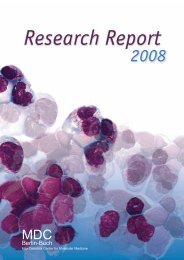iMDC03 zum Download (pdf)
iMDC03 zum Download (pdf)
iMDC03 zum Download (pdf)
Erfolgreiche ePaper selbst erstellen
Machen Sie aus Ihren PDF Publikationen ein blätterbares Flipbook mit unserer einzigartigen Google optimierten e-Paper Software.
two Lighthouses<br />
for the mDc<br />
text barbara Urban<br />
tran s lation carOL ObErschmiDt<br />
In the middle of a small wooded area on the Buch Campus, two lighthouse<br />
structures stand on the left and right side of the road leading to the new<br />
Experimental Research Center (ERC). People passing by for the first time are<br />
amazed by the play of colors emanating from the installation. The colors of<br />
the beacons change depending on the distance and angle of the viewer.<br />
Lighthouse beacons are important navigation aids for ships. They can be<br />
seen from afar and are a visible signal even at night to distant ships seeking<br />
their way. The beacons of Eliasson’s light houses on campus look exactly like<br />
those in real lighthouses and are made of so-called Fresnel lenses, which<br />
were developed in the early 19th century by Augustin Jean Fresnel, a French<br />
physicist, to significantly reduce the weight and size of lenses in lighthouses.<br />
Optical glass lenses with a short focal length are usually very thick and<br />
consequently very heavy. The trick was to construct the lens out of concentric<br />
annular sections known as Fresnel zones. The light is refracted depending on<br />
the angle of the ring-like sections in relation to each other. There are two<br />
types of Fresnel lenses used in beacons: the belt-like cylindrical type and the<br />
headlight type.<br />
But how did the Buch research campus come to have two lighthouses? They<br />
are part of the Sculpture Park inaugurated on campus in the year 2000. In<br />
the late 1990s the MDC acquired artworks for this park from funds of the<br />
German Class Lottery. The idea was to support young artists and involve them<br />
in the creation of the Sculpture Park. Thus, Olafur Eliasson, then 32 years old,<br />
was asked if he could imagine creating something for the research campus<br />
in Berlin-Buch. Like all other artists participating in the Sculpture Park, he<br />
was allowed to pick the location for his installation. The first version Eliasson<br />
designed for his contribution was an arc of water. For various reasons,<br />
this idea could not be realized. Instead, Eliasson created a light installation<br />
consisting of two lighthouses.<br />
Lighthouses are a recurrent theme in Eliasson’s work of this period. In<br />
1999 he positioned single lighthouses at five sites in Tuscany and entitled the<br />
installation “Five Orientation Lights”. The five small light housesdivide the<br />
CaMpus anD people<br />
area in different sectors by illuminating<br />
them in different colors. Their<br />
light shines through Fresnel lenses<br />
that are mounted in a multifaceted<br />
glass enclosure made of colored<br />
glass. Thus, according to Eliasson’s<br />
work description, a secondary grid<br />
is introduced to the landscape – not<br />
by using the usual cartographic<br />
methods but by means of a color<br />
code. Much like in “Five Orientation<br />
Lights”, the light installation in<br />
Berlin-Buch consists of lighthouse<br />
structures. Only here the two light<br />
houses are positioned across the road<br />
from each other. Both light sources<br />
are assigned a color field, through<br />
which the surrounding area is divided<br />
into colored segments. During the<br />
same period Eliasson created another<br />
lighthouse installation south of<br />
Malmö: “The Movement Meter for<br />
Lernacken” (2000). It also consists<br />
of two parts and is located not<br />
far from the Øresund Bridge, the<br />
combined highway-railway bridge<br />
connecting Sweden and Denmark.<br />
Eliasson’s lighthouse installations<br />
extend the original meaning<br />
of lighthouses. No longer are they<br />
only navigation aids to determine<br />
the exact position at sea. Rather,<br />
they structure their surroundings<br />
on land, thus arousing the viewer’s<br />
curiosity. The installations “Five<br />
Orientation Lights” or “Movement<br />
Meter for Lernacken” are visible in<br />
the countryside from a far distance.<br />
Eliasson’s lighthouses captivate<br />
people’s attention – some more so,<br />
some less. On the Buch campus the<br />
story goes that the lighthouses made<br />
such an impression on a truck driver<br />
that he brought his vehicle to a halt<br />
right in front of them, believing they<br />
must be some kind of light barrier.<br />
He got out, walked through the color<br />
spectrum, testing to see if anything<br />
would happen. Nothing did, and after<br />
a while he got back into his truck<br />
and continued driving on his way…<br />
imdc03 2012<br />
83
















